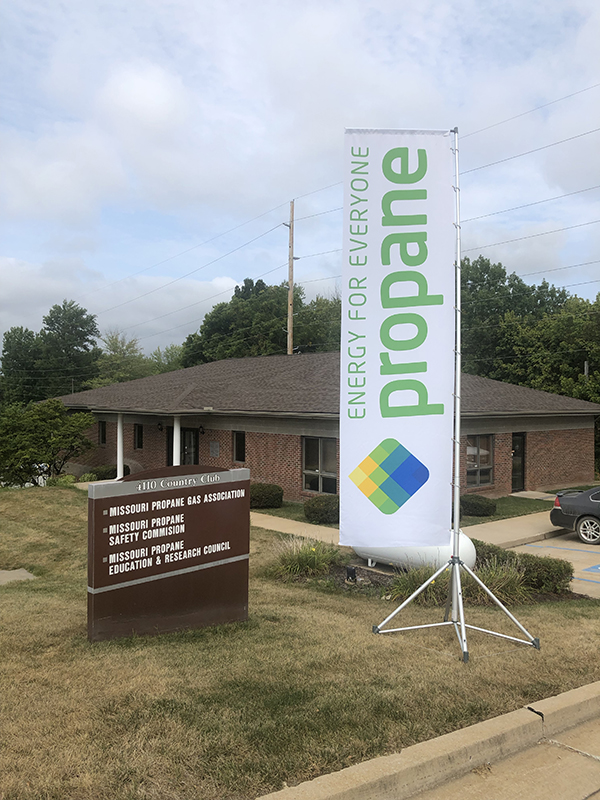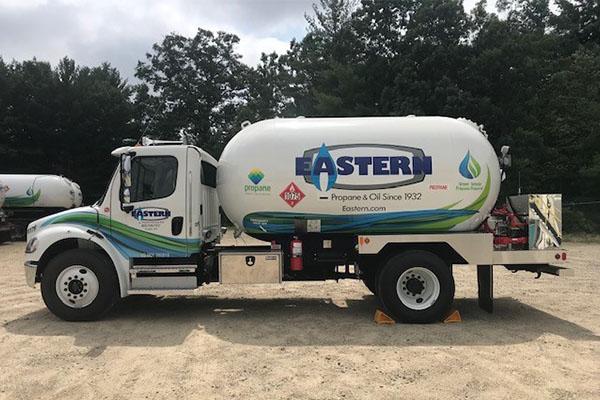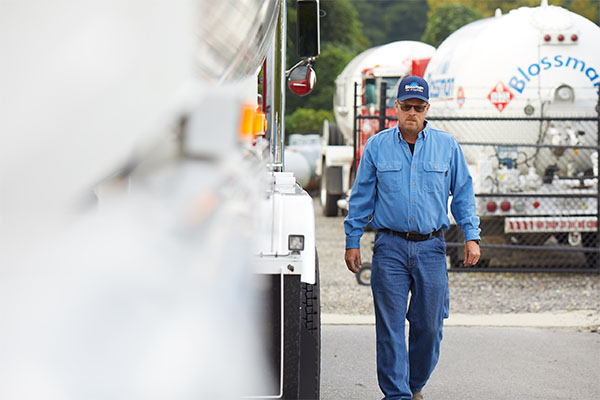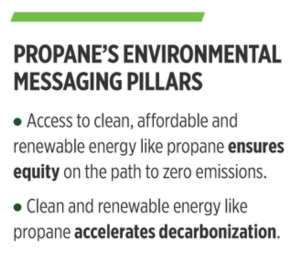Environmental campaign aims to secure propane’s future role
You’re reading the final installment of a three-part series about the propane industry’s new environmental messaging campaign. Read part one and two.

Photo courtesy of Missouri Propane Education and Research Council
In Reno, Pennsylvania, along a scenic stretch of the Allegheny River, a young manager’s work at the family propane business goes hand in hand with her commitment to leave the condition of the planet better than she found it.
Like many millennials, 29-year-old Monika Goss’s interest in environmental issues began at a young age – she started a recycling program at her high school, and now, she makes sustainability a priority as assistant general manager at RN Goss Gas Products.
One of her projects involves onboarding propane autogas vehicles for the company’s fleet. RN Goss Gas Products operates five of its trucks on propane, with two more on order, and has decided to purchase only propane-powered vehicles going forward.
“We try to practice what we preach,” says Goss, who has also worked to go paperless and educate customers about the clean-burning nature of propane.
Goss’s commitment to sustainability reflects views widely held by her generation and younger Americans. Millennials (born between 1981 and 1996) and Generation Z (born between 1997 and 2012) prioritize environmental and social issues as homeowners, consumers and, increasingly, as business and civic leaders.
Goss believes the future of the propane industry depends on successfully navigating this generational shift.
“If you don’t appeal to us, if you don’t get our buy-in, there is no future for propane,” she says. “We’re going to be the ones buying the houses. We’re going to be the ones passing the legislation. We’re going to be the ones who make or break this industry going forward.”
The same reasoning drove the National Propane Gas Association (NPGA) and the Propane Education & Research Council (PERC) to develop a new identity for propane – including environmental messaging, an updated logo and a new tagline, “Energy for Everyone.”
One of the goals of the campaign is to assist the propane industry in engaging more effectively with younger generations as they carry the U.S. economy and energy sector into the future; the industry’s ability to communicate shared environmental and social goals will determine whether it grows its consumer base, capitalizes on new opportunities and proves it’s the right energy choice for today and tomorrow.
A changing world
Millennials became the largest cohort in the U.S. workforce in 2015, and as they gain leadership responsibilities, they’re changing what it means to do business.
Young leaders have embraced sustainable development goals – a United Nations initiative to improve prosperity for people and the planet – as well as environmental, social and corporate governance tenets – criteria for socially conscious investors to screen potential investments.

Eastern Propane & Oil of Rochester, New Hampshire, displays propane’s new identity on a propane-powered bobtail and its service tech vans. It plans to refresh the look of its sales team trucks next. Photo by Nathan McShinsky
Propane marketers should start considering how their business models and partnerships fit into these frameworks, suggests PERC President and CEO Tucker Perkins.
“There’s a tremendous opportunity that we have looked past so far about how companies that want to improve their environmental position could be choosing propane,” says Perkins.
This doesn’t mean propane marketers need to change their business models, he adds, but they might consider how to grow gallons and expand business networks in ways that also provide environmental benefits to their communities.
“As we think about the industry maturing and changing, clearly, I think there’s an opportunity for autogas; there’s an opportunity for power generation, prime power generation; there’s an opportunity for enhanced use on the farm. And I think the other action marketers need to start taking is: Do they have the relationships with equipment vendors that sell this next level of modern equipment?”
One of PERC’s key roles in the industry’s environmental playbook is to assess how the energy sector will change in the next decades and ensure the industry has the equipment, appliances and systems to remain competitive and continue to meet environmental and social challenges, explains Perkins: “There’s an agonizing amount of science and technology and commercial development to make sure we’re prepared not just for 2022 but for 2030, 2040 and 2050,” he says.
For example, PERC sees opportunities for propane in microgrids – decentralized energy systems that serve discrete geographic footprints such as college campuses or hospital complexes – as communities seek more resiliency than the centralized, and increasingly vulnerable, electric grid can provide.
Microgrids typically consist of a solar photovoltaic system, battery storage and a backup generator system that can run on propane or other fuels. According to two PERC case studies, propane offers economic and environmental benefits that make it the best low-carbon fuel choice for microgrids compared to diesel-powered systems.
Other opportunities for propane in a clean energy future include micro combined heat and power units – which can simultaneously produce electricity and heat space and water, using a combination of energy sources – or expanded use of propane autogas in medium- and heavy-duty truck categories.
Moving molecules
Industry leaders say propane marketers should also anticipate change right down to the fuel itself.
A number of players in the propane industry are working to bring fuels with a lower carbon intensity than conventional propane to commercial mass. Conventional propane can be blended with renewable propane or renewable dimethyl ether – which has an ultra-low carbon or even negative carbon intensity – to meet stringent emissions standards.
Such fuels are similar in composition to conventional propane and can be distributed with minimal modifications to the propane industry’s infrastructure and workforce.

A Blossman Gas transport driver delivers renewable propane. Photo courtesy of Blossman Gas
“Our industry needs to think of itself as an industry that’s already got the infrastructure, the people, the resources, equipment to move molecules, not just propane, five and 10 and 15 years from now,” says Stuart Weidie, PERC chairman and president and CEO of Mississippi-based Blossman Gas.
Blossman Gas and California-based Blue Star Gas are already proving it can be done. To date, the two companies have dispensed 12 million gallons of renewable propane to the transportation sector.
In 2018, Blossman Gas partnered with the Mobile County Public School System in Alabama to begin using renewable propane in county school buses.
As a marketer with experience supplying renewable propane, Weidie wants to initiate a serious discussion about using renewable propane to position the industry as a modern energy provider.
“If we expect to grow gallons while ignoring public perception and policymakers’ goals, we risk losing the status as a viable energy source in the future,” he says.
In California, the propane industry is sponsoring a bill to incentivize use of renewable propane in residential and commercial buildings as well, explains Jeff Stewart, president of Blue Star Gas.
Admittedly, renewable propane is not yet available to the majority of propane marketers. But as industry members have conversations with stakeholders, current use of renewable propane can serve as a “substantiated, not fictitious, example of having a very low-carbon solution that will be available in parts of the country, initially, where there are incentives for that fuel,” says Stewart.
Chris Caywood, president of Caywood Propane Gas, based in Michigan, doesn’t shy away from talking about renewable propane despite the fact he can’t obtain it. For him, it’s a matter of survival.
“I can’t source renewable propane today,” he says. “When it can be sourced at a level that makes it economically feasible, I intend to do so. I think it’s important for us as an industry to understand that if we don’t do that, our days truly are numbered.”
He thinks that number is less than three decades, based on the activity of statehouses around the country.
Michigan is just one of many states that have passed or proposed a renewable energy requirement that must be met within the next 10 to 30 years.
No need to apologize
The core messages of the industry’s environmental campaign – that propane ensures equity on the path to zero emissions and accelerates decarbonization – underscore propane’s current environmental strengths and outline what it must continue to accomplish to remain competitive for decades to come.
 To pave the way for new possibilities and innovations, the industry must start telling its environmental story today and should do so confidently, say industry leaders.
To pave the way for new possibilities and innovations, the industry must start telling its environmental story today and should do so confidently, say industry leaders.
“We have not done a good job of talking about how low carbon a fuel we are,” says Stewart, referring to conventional propane.
Simply communicating what propane accomplishes right now, and has for decades, in terms of decarbonization and energy equity would bring the industry “raving success,” he says.
“We have nothing to apologize for,” he adds.
Inevitably, as the industry’s messages spread, marketers should prepare to engage with parties that believe propane, as a fossil fuel, perhaps should apologize.
When Stephanie Hennen, the 26-year-old manager of marketing and customer service at Lakes Gas in Minnesota, engages with peers, she sometimes gets pushback about propane’s status as a fossil fuel.
In these situations, she informs them about renewable propane and invites them to examine how electricity in the Upper Midwest is produced. When they realize coal-powered plants produce a lot of the electricity, they often accept they hadn’t thought about the possible drawbacks of electricity from an environmental standpoint, she says.
These conversations complicate the agenda pushed by the electrify-everything movement – that a single energy source or mode of energy transport can accomplish it all – and open the door to talk about the benefits of propane. Hennen encourages her peers to look at the science and determine how a variety of energy sources, including propane, can work together for a better future.
“It’s not a me-versus-them or us-versus-electricity conversation,” says Hennen. “It’s more: We’re here to help, and we’re here to be a part of the solution for a cleaner environment.”
When the National Propane Gas Association (NPGA) and its affiliates present arguments about a dirty electric grid in many areas of the country, resistant decision-makers often respond that they simply need more time and subsidies to develop renewable systems based on solar or wind.
“My response to that,” says Steve Kaminski, president and CEO of NPGA, “is if they have the time to develop those systems, why don’t we have the time to continue developing renewable propane, to continue developing blends, to continue making our fuel cleaner as well? If you’re going to give them a runway between now and, let’s say, 2030 to clean up their grid, give us the same runway, too.”
Propane’s value proposition focuses on more than decarbonization. Transmission of electricity in the U.S. is inefficient, according to campaign messaging, and the cost of upgrading the grid will fall on people who can least afford it. Propane, on the other hand, is ready to provide clean, reliable, on-site energy now.
Kaminski says the messaging around cost and equitable access to energy are “resonating very well” in swing states and liberal capital houses that generally demonstrate stronger support for renewables like wind and solar.
Stewart says the industry has “gone to great lengths” to develop a robust set of messages that are supported with facts and data so that propane marketers can respond well to counterarguments. He encourages marketers to familiarize themselves with the resources available from PERC and NPGA so, when challenged, they can respond readily or, at least, direct the concerned party to the appropriate sources of information.
Measures of success
As the industry executes its new environmental playbook on several fronts, leadership is gauging success in several ways.
Stewart will know the industry is communicating well on all levels when propane is acknowledged as a part of the solution rather than part of a historical fossil fuel problem in the national energy conversation.
Weidie has his eye on the industry’s ability to innovate more environmentally friendly products, bring renewable propane to market and stop onerous regulations.
Expanding uses and users of propane is the ultimate metric of a successful messaging campaign for PERC, says Perkins.
“I really do believe that the next five or 10 years, we could see tremendous growth in our industry because we are a strong alternative to coal, to oil, to wood, to diesel fuel,” he adds. “We just have to see that we continue to get a seat at the table, and that we are not looked past in favor of something that doesn’t exist right now. And if it existed, perhaps people couldn’t afford it.”
The rollout of the new messaging, brand and support materials is just the beginning of a long-term game plan that will determine whether the industry remains competitive in the decades to come.
Weidie likens it to the top of the first inning.
“It’s an ongoing effort. Essentially a never-ending effort,” he says.
For Caywood, the effort to learn about propane’s new identity and run an operation with environmental and social awareness is a deeply personal investment in the future. He and his brother are third-generation owners of a family business that has sold petroleum-based products for more than 80 years.
“It’s time to move to the next step in the life cycle of our world,” he says.
After all, he has three young daughters whose futures he’s taking to heart.
2021 LP Gas Rising Leaders weigh in
We asked Monika Goss of RN Goss Gas Products and Stephanie Hennen of Lakes Gas, both 2021 LP Gas Rising Leaders, what their fellow marketers should know about engaging with younger generations in the propane industry and beyond. Responses are edited for brevity and clarity.

Goss
LP Gas: What would you like your fellow propane marketers to understand about young generations when it comes to environmental issues?
Goss: I think when people think of propane, they group it with the more dirty oil and gas industry. I think a lot of consumers blindly think, “Oh, fossil fuel – it’s bad.” And they think anything related to electricity is good. I’m not saying electricity is bad, but I think propane should be grouped with other clean energies like solar and wind power.
Hennen: Gen Z will not work with a company if they don’t like the views of that company. And one of the big values that millennials and Gen Z have is a clean environment and clean energy sources. Just having that conversation, whether it be via social media, your website, that’s something that is going to relate very well to younger people, and so they’re going to be more comfortable using you as an energy source.
LP Gas: How do you respond to critiques that propane is a fossil fuel?
Goss: Being a millennial, I love Google. So I just did some Google searches on some of the buzzwords like “reduced emissions” or “decarbonization” or “low carbon.” And the first however many pages, propane never popped up. It was all wind, electricity, solar – none of it was propane. So I think people aren’t exposed to it, and education is going to be really big. Some people have already formed their opinions on this stuff. And if they don’t see anything differently, they’re going to keep thinking the way they think. And we just need to challenge that perception. We need to get the word out, especially to the younger generations who might be open to viewing things differently or might be open to a change.

Hennen
Hennen: This is one of my favorite things about being able to work in the industry. I get the chance to talk to a ton of different people – new people that I meet, my current friends – and talk to them about propane and about the benefits to the environment. And after every conversation I have with them, they always say, “Oh, I didn’t know propane did that.” So there are just so many things people don’t understand about the industry. When I’m able to talk one-on-one to people my age, or even younger, I can help bring up those facts about decarbonization, and that we’re a low greenhouse gas emissions fuel. One of the things that I’ve been kind of working into my conversations lately is that there’s no one energy source that can fix and save everything.
LP Gas: What are the best ways to target younger audiences?
Goss: We’re all glued to our smartphones, I suppose. But not only where you advertise but how you advertise matters. Pushing the points of sustainability and environmental friendliness catches our eye more than “Hey, look how cool this is, or how cheap this is.” I do think we’re more aware of the impact on the environment.
Hennen: One thing I want to see more of is working with influencers. I know that we are working with quite a few influencers, but I think that’s going to be one of our greatest strengths is to work with even more – across regions, and whether it’s home or cooking or outdoor environmentalists – to begin working with even more that have bigger followings.
LP Gas: What advice do you have for fellow marketers as they learn more about environmental issues and implement this campaign?
Goss: Just keep trying to educate. I think there are a lot of misconceptions about propane. The more facts we can get out there – the more we can talk about the benefits of propane – the better.
Hennen: A lot of people my age tend to be more futuristic. We want to work for a cause. We want to make sure we’re doing good things. And a lot of that feeling stems from doing good things for the earth and doing good things for the environment so that we have a place we can live comfortably for years to come. As long as you’re able to understand the views we’re coming from, in no way, shape or form are young people trying to shut down the fuel industry. We just want to make sure that there are clean options for us to utilize and that we’re helping the environment move in a positive direction.
















